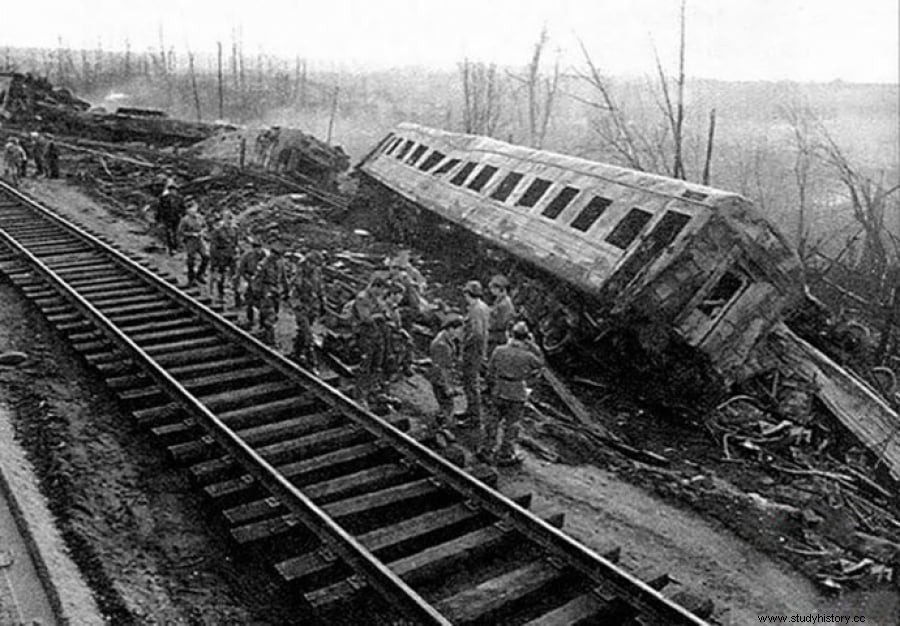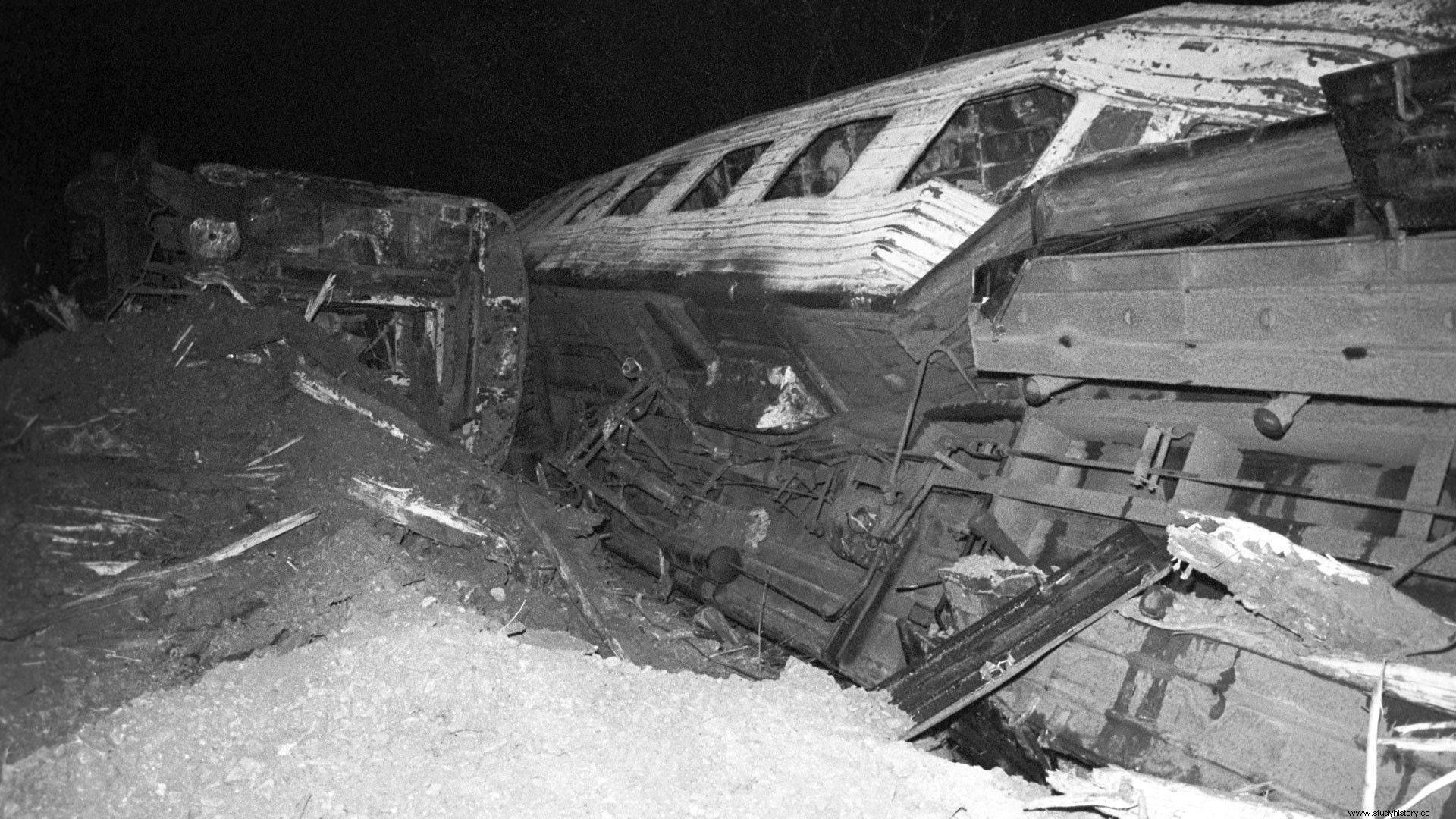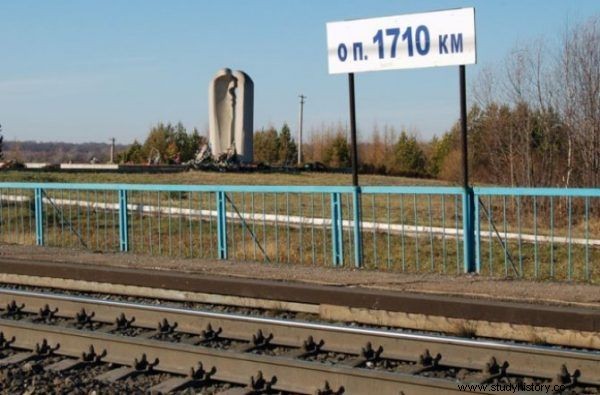The greatest railway disaster in the history of the Soviet Union took place at 1:14, June 4, 1989 on the section Asha - Ufa (1710 km of the Trans-Siberian Railway), right on the border between Bashkiria and the Chelyabinsk region. As a result of the explosion of a propane-butane mixture, two trains carrying nearly 1,400 passengers and crew members were destroyed, 600 of them did not survive the consequences of the accident. In addition, the fire destroyed 200 hectares of forest.
From a technical point of view, the disaster was caused by an unsealed gas pipeline, but in fact the source of this tragedy was ordinary human neglect and disregard of duties on the part of employees. The Western Siberia - Ural - Volga pipeline along which these trains traveled was put into service in 1984.
It was originally intended to transport crude oil, but just before its construction was completed, the authorities decided that instead of oil, a mixture of propane, butane and heavier hydrocarbons would be pumped through pipes with a diameter of 720 mm. This required changing the entire infrastructure, but it was never done.
Moreover, near the crash site, the excavators damaged the pipe, which was covered with earth. The acceptance act was signed without checking whether the gas pipeline is fit for use.
Shocking Shortcomings
In addition, the pipeline passed too close to built-up areas and railroads, so automatic gas detection systems had to be installed there for safety reasons. Economics stood in the way again.
It was decided that the pipeline would be sealed by helicopters and crosswalkers, but the former were soon abandoned in the hope that local residents would inform the relevant authorities about the gas leak.
The pipe located a few meters from the track was unsealed on June 3, 1989. Employees of a nearby refinery noticed a pressure drop in the gas pipeline and on the same day, at 21, notified the pipeline operator. This one was in a hurry to get the bus home and did not pass the news to his co-worker, who increased the gas pressure, causing another leak.
The drivers on this section of the trains also informed the dispatcher about the strong smell of gas, but also in this case there was no reaction. In this way, the amount of escaping gas increased, which was favored by the fact that the leakage point was in a valley.
A looming tragedy…
Meanwhile, two trains were approaching the site of the tragedy:one with no. 211 from Novosibirsk - Adler and the other with no. 212 Adler - Novosibirsk. The first was headed for the Black Sea coast of the Caucasus, and the second was returning from this resort. As it was the peak of the holiday season, all tickets have been redeemed.
The driver of the train No. 211 reported to the dispatcher that he saw a "strong fog" in front of him, not suspecting that it was a cloud of gas. And when this train passed by the train No. 212, which was going from the opposite direction, a powerful explosion took place. It could have been caused by a cigarette butt thrown out of the window or - more likely - by a spark caused by braking one of the trains after descending into the valley.

The power of the explosion was 300 tons of TNT.
Later studies showed that if the trains had entered this zone one at a time, the explosion would not have happened. In fact, these two trains had no right to meet at this place, but unfortunately they were late:No.211 - for technical reasons, and the one at No.212 had to make a longer stop so that the ambulance could take the woman to the hospital. premature labor has started.
The power of the explosion was 300 tons of TNT. The flames were visible several dozen kilometers from the scene, and in the city of Asha, 11 km away, windows in many houses fell out. The explosion was even recorded at the headquarters of the North American Air and Space Defense Command . The Americans even thought that there was another nuclear explosion in the Soviet Union, but due to the lack of an electromagnetic pulse, it turned out that their assumptions were wrong.
Hell
Local policemen immediately went to the scene of the tragedy. What they found there surpassed their worst expectations. The explosion literally threw 11 wagons off the tracks, 7 of them completely burned down. The remaining 27 were completely burnt inside. The tracks were broken or… knotted.
Many people were burning like living torches and the policemen rushed to help them. Some passengers literally turned to dust, making it impossible to identify them.
Molten gold jewelry was found on the victims, which means that the temperature at the epicenter of the blast exceeded 1000 degrees. Whole families died in the explosion; 9 members of the youth hockey team (boys born in 1973) also lost their lives. It is estimated that over 250 passengers died at the scene of the tragedy.

As a result of the very high temperature formed during the explosion, some of the bodies evaporated.
Ambulances also went from Asha and Ufa, and they wandered for a long time because the dispatchers did not know the exact place of the event. Due to the lack of access roads, the medical teams had to travel part of the way on foot. Doctors and nurses were only told about the fire of one of the carriages, so they were not prepared for the terrible sight at the crash site. There was not enough hands to help - students of the military school were working to transport the wounded. Helicopters took the most seriously injured to hospitals. Years later, participants in these events reported that when burned persons were touched, their skin peeled off.
Local doctors often lacked knowledge of how to treat burns, so a teleconference with specialists in Moscow and Leningrad was organized. As a policy of openness (glasnost) was introduced in the Soviet Union, American experts were involved in consulting the most serious cases. Despite the help of experienced specialists, 317 of 620 people in the hospital died.

Due to the lack of access roads, the medical teams had to travel part of the way on foot
The total number of victims ranged from 575 to 645; this discrepancy was due to the fact that children under 5 did not need tickets and therefore were not included in the statistics. Almost 1/3 of the dead - 181 people - were the youngest. In addition, 600 passengers remained disabled.
Miraculous survivors have also happened. Several hours after the explosion, a man dressed in a well-tailored suit, with a briefcase in his hand and a hat on his head, reported to the crisis management staff. It turned out that he survived the explosion unscathed, but due to the shock he had suffered, he wandered in the surrounding forests for many hours.
One young man reported to a police station in Ufa to confirm that he was alive. He was saved by… alcohol. The man got off the train during a long stop to buy a beer. He liked the drink so much that the passenger stayed at the station for further consumption and the train left without him.
Consequences
After a few days, traffic on the damaged section was resumed. Soon - near the site of the tragedy - ceremonial funerals of the victims buried in the mass grave took place. In honor of their memory, an 8-meter obelisk was erected. Access roads were also built so that the relatives of the deceased could visit their resting place.

All trains crossing the 1,710 km of the Trans-Siberian Highway stop to pay tribute to the victims.
All trains that cross the 1710 km of the Trans-Siberian Highway stop to pay tribute to the victims.
As the disaster happened during perestroika. Mikhail Gorbachev, the General Secretary of the Central Committee of the Polish United Workers' Party, arrived at the scene of the accident on June 4, 1989 and declared that the case would not be swept under the carpet and that the guilty parties would be punished.
This did not happen, however, because the charges were not brought against decision-makers, , but to the hurdles - 9 people working on the construction of the gas pipeline. After 6 years of investigation, only 2 of them were punished - they were forcibly sent from the city of Ufa.
